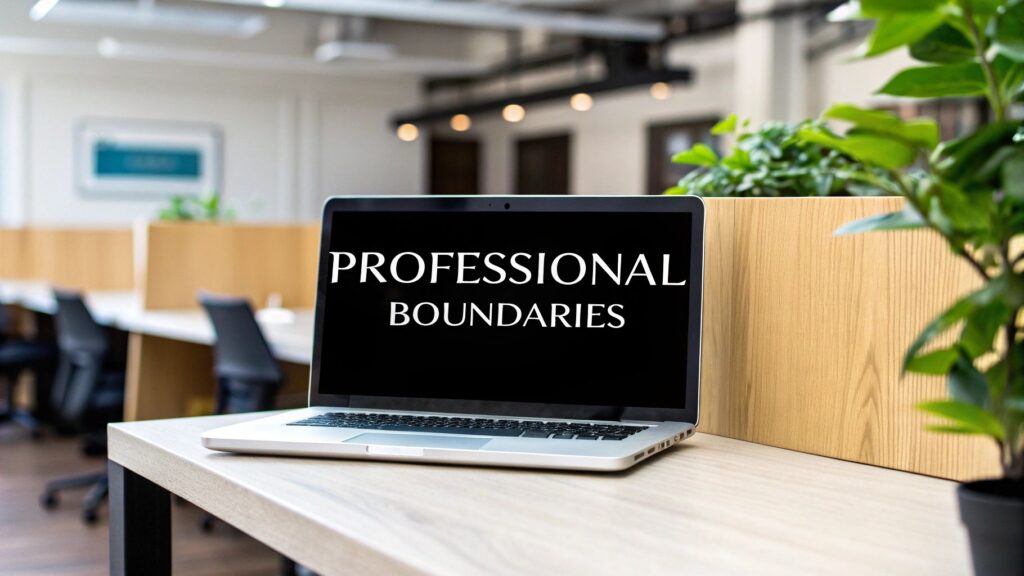In today's 'always-on' work culture, the lines between our professional and personal lives can easily blur, leading to burnout, stress, and fizzling productivity. The key to reclaiming your time and mental clarity isn't just working harder; it's working smarter by establishing and maintaining professional boundaries. These aren't about building walls or being unapproachable. Instead, they are the essential guidelines that protect your energy, define your role, and foster respectful, sustainable relationships with colleagues and clients.
Think of professional boundaries as the clear, mutually understood rules of engagement that allow you to bring your A-game without sacrificing your personal well-being. They're a sign of self-respect and a cornerstone of a healthy, long-term career, whether you're a freelancer, a small business owner, or part of a larger team. Without them, you risk client scope creep, chaotic communication, and a work-life balance that feels perpetually out of whack.
This guide gives you eight concrete, actionable strategies to help you master the art of maintaining professional boundaries, ensuring you can thrive both in and out of the workplace. We'll move beyond generic advice to give you practical steps you can implement today, covering everything from communication protocols and time management to managing your online presence and client relationships. You'll learn exactly how to set these limits, communicate them effectively, and uphold them with confidence.
1. Establish Crystal-Clear Communication Protocols
The foundation of any strong professional boundary is clear and consistent communication. When you don't define the rules of engagement, you leave the door wide open for late-night texts, "urgent" emails that aren't, and a general sense of being on-call 24/7. Establishing crystal-clear communication protocols is the first, most crucial step in reclaiming your time and managing expectations.
This means being upfront about how, when, and where you communicate. It’s not about being rigid; it’s about creating a predictable framework that allows both you and your clients or colleagues to work together efficiently. When everyone understands the playbook, the game runs much smoother, and you're better able to focus on delivering high-quality work.
How to Implement This
Successfully setting these boundaries involves more than just thinking about them; you must document and share them. Check out these real-world examples:
-
For Freelancers & Consultants: A freelance graphic designer provides every new client with a "Welcome Packet" PDF. This document clearly outlines their office hours (e.g., 9:00 am – 5:00 pm, Monday to Friday), a commitment to a 24-hour response time for non-urgent emails, and specifies that all project feedback must be submitted via a designated project management tool to keep it organised.
-
For Teams: A project manager sets up specific channels in a team chat app like Slack. There’s a channel for general announcements, one for each major project, and even a "social" channel. This prevents important project details from getting lost in a sea of random messages and helps the team focus.
-
For Service-Based Businesses: A plumber or electrician uses a dedicated business phone line for all client calls and enquiries. Their voicemail greeting clearly states their service hours and provides an emergency contact number for genuine out-of-hours crises, immediately filtering routine queries from true emergencies.
Actionable Tips
- Create a Simple Policy: Draft a one-page "Communication Guide" and share it during onboarding. This small step sets a professional tone from day one.
- Leverage Automation: Use out-of-office auto-responders on your email and "Away" messages on messaging apps. This reinforces your working hours and manages expectations about when you'll reply.
- Separate Your Channels: Keeping work and personal life separate is vital. To avoid clients messaging your personal WhatsApp at all hours, consider a service like Business Numbers Direct to get a dedicated business number on your existing phone. This allows you to use WhatsApp Business professionally, keeping your personal number private while maintaining a polished client-facing presence.
2. Set Firm Time and Schedule Boundaries
Without defined working hours, your professional life can quickly bleed into your personal time, leading to burnout and resentment. Setting firm time and schedule boundaries is about protecting your most valuable, non-renewable resource: your time. It means clearly defining when you are "on the clock" and when you are not, and then rigorously defending that divide.
This isn't about working less; it's about working smarter. By creating a structure for your availability, you empower yourself to be fully present and productive during work hours and completely disconnected during personal time. This practice of maintaining professional boundaries is fundamental to long-term career sustainability and personal well-being.

How to Implement This
Protecting your time requires proactive strategies that are communicated clearly and consistently. Here are some real-world examples of how different professionals apply this:
-
For Healthcare Professionals: A therapist clearly states in their client agreement that sessions are strictly 50 minutes and will end on time, even if the client is late. They do not respond to non-emergency client messages outside of their stated office hours of 9 am to 6 pm, protecting their own mental health.
-
For Remote Workers: A software developer uses calendar blocking to schedule "deep work" sessions in the morning for coding and reserves afternoons for meetings. They set their status on team chat apps to "Away" after 5:30 pm and turn off notifications on their phone to create a clear end to their workday.
-
For Executives & Managers: A small business owner blocks out two hours every Friday morning in their calendar as "Strategic Planning Time." This slot is non-negotiable and communicated to their team, ensuring they have protected time to work on the business, not just in it.
Actionable Tips
- Use Calendar Blocking: Schedule your personal appointments, breaks, and family time in your calendar with the same importance as client meetings. This makes your unavailability visible to others.
- Create 'Office Hours': Even if you work flexibly, establish and communicate core hours when you are available for calls and rapid responses. Let people know when to expect a reply.
- Practise Saying No: Politely decline requests that fall outside your established work hours. A simple, "I can't get to that today, but I will make it my first priority tomorrow morning" reinforces your boundaries respectfully.
- Automate Your Availability: Add your working hours (e.g., Mon-Fri, 9 am – 5 pm) to your email signature. This acts as a constant, gentle reminder to clients and colleagues about when you are available to them.
3. Physical and Digital Workspace Boundaries
In today's interconnected world, especially with the rise of remote work, the lines between our professional and personal lives can easily become blurred. Creating a distinct separation between your work and home environments, both physically and digitally, is fundamental to maintaining professional boundaries. When your living room is also your office and your personal phone gets client notifications, it’s tough to mentally switch off and protect your private time.
This boundary is about building psychological and practical barriers that signal when it's time to work and when it's time to rest. Just as a physical office door provides a clear separation, digital partitions help prevent work from creeping into every moment of your day, ensuring you remain focused during work hours and properly disconnected after.

How to Implement This
Successfully creating these separations requires deliberate action to silo your professional activities from your personal life. Consider these real-world examples:
-
For Home-Based Consultants: A freelance marketing consultant working from a small flat dedicates a specific corner of their room as their office. They use a room divider screen to physically block it from view after 5:30 pm, signalling that the workday has officially ended.
-
For Legal Professionals: A solicitor maintains two separate mobile phones: one strictly for client communication and business, and another for personal use. This ensures client confidentiality is upheld and prevents personal interruptions during work hours, and vice versa.
-
For Social Media Managers: A content creator who manages multiple client accounts uses separate, dedicated web browser profiles (e.g., in Google Chrome) for each client and another for personal browsing. This keeps logins, cookies, and browsing history completely separate, preventing accidental posts from the wrong account and enhancing security.
Actionable Tips
- Create Physical Separation: Even without a dedicated office, designate a specific desk or area for work. At the end of the day, pack away your laptop and work materials to create a clear "end of work" ritual.
- Use Different Digital Profiles: Leverage features like browser profiles or separate user accounts on your computer for work and personal use. This keeps bookmarks, history, and logins organised and distinct.
- Establish a Digital 'Shutdown': Turn off work-related notifications on your phone and computer outside of your defined work hours. This small action is crucial for protecting your personal time and maintaining professional boundaries in a digital world.
4. Draw a Line with Emotional and Personal Information
Navigating the line between being a friendly, approachable professional and becoming an unofficial therapist or best friend is a delicate art. This boundary is about managing personal disclosure and emotional involvement. It means being empathetic and supportive without taking on the emotional weight of a client's or colleague's personal life, ensuring relationships remain professional, respectful, and focused on the job.

When this boundary gets fuzzy, it can lead to emotional exhaustion, compromised objectivity, and unprofessional dynamics that hurt both parties. As influential researcher Brené Brown's work highlights, healthy boundaries are not a sign of being distant; they are a prerequisite for genuine connection and compassion. Maintaining professional boundaries in this area protects your mental energy and keeps the professional relationship on solid ground.
How to Implement This
Putting this into practice requires self-awareness and intentional communication. The goal is to show you care without becoming overly entangled. Here are some real-world examples:
-
For Healthcare Professionals: A doctor listens with empathy to a patient's anxieties about their health but avoids getting drawn into family dramas or personal conflicts. They offer support related to the medical situation and direct the patient to a counsellor for emotional issues beyond their scope.
-
For Managers: A manager notices an employee is struggling due to a personal issue. Instead of trying to solve the problem themselves, they express support, remind the employee of the company's confidential employee assistance programme (EAP), and discuss flexible work options to help them cope. This is supportive without being intrusive.
-
For Service Providers: A freelance web developer has a friendly relationship with a long-term client. When the client starts venting about their personal life during project calls, the developer gently redirects the conversation by saying, "It sounds like you're going through a lot. For the sake of time on this call, shall we get back to the website mock-ups?"
Actionable Tips
- Develop Polite Deflections: Prepare a few standard, polite phrases to use when conversations stray too far into personal territory. Something like, "I appreciate you sharing that with me, but I'd like to keep our focus on the project," works well.
- Practise Active Listening Without Absorbing: You can validate someone's feelings ("That sounds incredibly challenging") without taking their emotional burden as your own. Listen, acknowledge, and then gently guide the conversation back to professional matters.
- Know Your Role: Remind yourself of your professional function. You are a plumber, a designer, or a manager, not a therapist. Recommending professional resources like therapy or financial advisors is often the most helpful and boundary-appropriate action you can take.
5. Financial and Gift-Giving Boundaries
Money and gifts can quickly complicate professional relationships, blurring the lines between a business transaction and a personal friendship. When you don't set firm financial and gift-giving boundaries, you open the door to awkward requests, potential conflicts of interest, and situations that can compromise your professional judgment. Establishing clear policies is essential for maintaining professional boundaries and keeping all interactions transparent and ethical.
This means being explicit about what is and isn't okay regarding gifts, favours, or any financial dealings outside of your agreed-upon services. It’s not about appearing ungrateful; it’s about protecting the integrity of your professional relationship. When clients or colleagues understand the rules, it prevents misunderstandings and keeps the focus purely on the work, which is crucial for long-term trust.
How to Implement This
Successfully setting these boundaries requires clear, upfront communication, often in writing. This removes ambiguity and provides a reference point if a tricky situation comes up. Consider these real-world examples:
-
For Healthcare Professionals: A therapist includes a "Policy on Gifts" in their new client intake forms. This document politely states that while they appreciate the sentiment, they cannot accept gifts of monetary value. It might suggest that a heartfelt thank-you card or a positive review online is the most welcome form of appreciation.
-
For Tradespeople: A plumber, often offered cash "tips" or gifts, sets a policy of politely declining. If a client insists, they might suggest the client donate the equivalent amount to a local charity the business supports, turning a potentially awkward moment into a positive community gesture.
-
For Consultants & Advisors: A financial advisor is bound by strict industry regulations. They provide clients with a disclosure document that explicitly forbids personal loans, co-investments, or accepting any gift exceeding a nominal value (e.g., £50) to avoid any perception of a conflict of interest.
Actionable Tips
- Create a Written Policy: Draft a simple, clear statement on gifts and financial interactions. Include it in your contracts, welcome packs, or on your website.
- Suggest Alternatives: If a client wishes to show gratitude, have pre-prepared, acceptable alternatives. Suggesting they leave a testimonial, refer a friend, or donate to a chosen charity are excellent options.
- Document Everything: In cases where a minor exception is made (e.g., accepting a small, corporate-branded gift), document it. This transparency protects you and demonstrates consistency in your approach to maintaining professional boundaries.
6. Social Media and Online Presence Boundaries
In today's hyper-connected world, the lines between our personal and professional lives can easily blur online. Failing to manage your digital footprint is like leaving the front door of your office wide open after hours; it invites unwanted access and can compromise your professional image. Setting clear social media and online presence boundaries is essential for controlling your narrative and maintaining your credibility.
This isn't about hiding your personality or becoming a robot online. It's about being strategic and intentional with what you share, where you share it, and with whom. A well-managed online presence lets you leverage powerful platforms for professional growth while protecting your private life, ensuring that clients and colleagues see the polished, professional version of you that you want to present.
How to Implement This
Successfully managing your digital identity involves creating a deliberate separation between your public professional persona and your private life. Here are some real-world examples:
-
For Healthcare Professionals: A dentist maintains an active, public Instagram account for her practice, sharing patient-friendly tips, success stories (with consent), and behind-the-scenes looks at the clinic. Her personal Facebook account, however, is set to private and is reserved for sharing family photos and personal updates with close friends and relatives only.
-
For Tradespeople: An electrician uses LinkedIn to connect with contractors and suppliers, sharing articles about new industry standards and project highlights. He avoids posting controversial political opinions or weekend party photos that could alienate potential clients looking for a reliable professional.
-
For Consultants & Coaches: A business coach uses Twitter and a professional Facebook page to share industry insights, articles, and upcoming webinar announcements. When a client sends a connection request to her personal Facebook profile, she politely declines and redirects them to her professional page, explaining it's where she shares all her business-related content.
Actionable Tips
- Audit Your Privacy Settings: Regularly review the privacy and security settings on all your social media accounts (Facebook, Instagram, etc.). Be explicit about who can see your posts, tag you, and view your personal information.
- Be Selective with Connections: Create a personal policy for handling connection requests. A good rule of thumb is to keep platforms like LinkedIn strictly for professional networking and platforms like Facebook for genuine personal friends and family.
- Think Before You Post: Before sharing anything online, ask yourself: "Would I be comfortable with a major client or my boss seeing this?" If the answer is no, it doesn't belong on a public or professionally-linked profile. This simple check is a powerful tool for maintaining professional boundaries.
7. Define Client and Customer Relationship Boundaries
In any service-based business, the line between friendly service and porous boundaries can easily blur. Defining client and customer relationship boundaries is about creating a professional framework that ensures you can deliver excellent service without compromising your objectivity, scope of work, or personal wellbeing. It protects both you and your client by managing expectations from the very start.
This isn’t about being distant or unapproachable; it's about being a reliable professional. When clients understand the limits of your role, they respect your expertise more and are less likely to make requests that fall outside your agreed-upon services. Maintaining professional boundaries is key to fostering long-term, healthy client relationships built on mutual respect, not on undefined availability.
How to Implement This
Clearly defining your professional role and its limits should be a core part of your client interactions. This protects you legally and professionally while ensuring the client receives the best possible service within your area of expertise.
-
For Therapists & Coaches: A therapist includes a "Therapeutic Agreement" in their onboarding paperwork. This document explicitly states their policy on out-of-session contact, dual relationships (e.g., not becoming friends on social media), and the specific scope of their therapeutic support, reinforcing the professional nature of the relationship.
-
For Accountants & Financial Advisors: An accountant provides a clear "Service Level Agreement" that distinguishes between tax preparation services (included in the fee) and more in-depth financial planning or business advisory services (available at an additional cost). This prevents scope creep and ensures they are compensated for all work performed.
-
For Personal Trainers: A personal trainer sets a firm boundary by explaining they can offer guidance on general nutrition that complements a fitness plan but must refer clients to a registered dietitian for medical nutrition therapy or specific meal plans. This respects professional scopes and protects them from liability.
Actionable Tips
- Integrate Boundaries into Contracts: Your initial client agreement is the perfect place to formally outline the scope of work, communication protocols, and other relationship boundaries.
- Create Referral Networks: Build a trusted network of other professionals (e.g., dietitians, legal advisors, specialist tradespeople). This allows you to say "no" constructively by offering a helpful alternative when a request is outside your scope.
- Develop Polite Scripts: Prepare and practise firm but kind phrases to address boundary violations. For example, "That falls outside the scope of our current agreement, but I'd be happy to point you toward someone who can help."
8. Define Clear Supervision and Mentoring Boundaries
When you step into a role of authority as a supervisor or mentor, the lines between supportive guidance and personal over-involvement can easily blur. Maintaining professional boundaries in these relationships is essential not just for your own wellbeing, but also for fostering genuine, unbiased professional growth in others. The goal is to be an effective guide, not an all-hours confidant or a crutch.
This involves consciously managing the inherent power dynamic. It’s about creating a safe, structured, and respectful environment where a mentee or supervisee can develop skills and confidence. Without clear parameters, these supportive relationships risk becoming co-dependent, creating favouritism, or leading to burnout for the person in charge. Properly defined boundaries ensure the relationship remains professional, productive, and fair to everyone involved.
How to Implement This
Setting these boundaries requires a proactive and transparent approach from the outset. It’s about defining the purpose and limits of the relationship so there is no room for misinterpretation.
-
In Academia: A university professor supervising a doctoral candidate establishes a formal "Supervision Agreement." This document outlines meeting frequency (e.g., bi-weekly), expected progress milestones, communication protocols (office hours only, no weekend contact), and clarifies that their role is to provide academic and research guidance, not personal counselling.
-
In a Corporate Setting: A senior manager mentoring a junior employee sets clear expectations in their first meeting. They define specific career goals to work on, schedule regular check-ins during work hours, and gently redirect conversations that stray too far into personal life, keeping the focus on professional development and workplace challenges.
-
In Healthcare: A medical supervisor training residents maintains a clear professional hierarchy during clinical rounds and training sessions. While offering robust support and teaching, they avoid overly familiar social interactions outside of work to prevent perceptions of bias and maintain a clear, authoritative command structure essential for patient safety.
Actionable Tips
- Establish a Formal Agreement: Create a simple document outlining the goals, scope, and boundaries of the mentoring or supervisory relationship. Review it together to ensure mutual understanding.
- Keep Meticulous Records: Document key discussions, decisions, and feedback. This creates a professional record of the relationship's progress and protects all parties.
- Seek Formal Training: Many professional bodies and organisations, such as the Chartered Management Institute (CMI), offer courses on effective leadership and mentoring. Investing in this training provides proven frameworks for managing these complex relationships.
- Schedule Regular Relationship Check-ins: Periodically ask, "Is this structure working for you?" This opens the door to adjust boundaries if needed and reinforces the professional nature of your dynamic.
8 Key Professional Boundary Areas Comparison
| Boundary Type | Implementation Complexity 🔄 | Resource Requirements ⚡ | Expected Outcomes 📊 | Ideal Use Cases | Key Advantages ⭐ / Tips 💡 |
|---|---|---|---|---|---|
| Clear Communication Protocols | Moderate – needs policy creation and enforcement | Moderate – tools for messaging, documentation | Reduced misunderstandings; predictable environment | All professional teams requiring structured communication | Reduces conflicts; protect personal time; use auto-responders |
| Time and Schedule Boundaries | Moderate – involves scheduling and discipline | Low to moderate – calendar tools, auto-signatures | Improved work-life balance; increased productivity | Roles with fixed hours or remote work | Calendar blocking; say no to violations; set clear availability |
| Physical and Digital Workspace Boundaries | Moderate to high – workspace setup and digital management | Moderate to high – devices, accounts, security tools | Better privacy; security; mental separation | Remote workers; those mixing home and work environments | Separate devices/accounts; strong passwords; physical barriers |
| Emotional and Personal Information Boundaries | High – requires ongoing self-monitoring and regulation | Low – mostly personal skills and training | Maintains professionalism and emotional stability | Managers, HR, healthcare professionals | Practice active listening; use professional language; peer support |
| Financial and Gift-Giving Boundaries | Low to moderate – policy creation and communication | Low – policy documentation | Prevents conflicts of interest; protects integrity | Government, finance, healthcare sectors | Clear policies; document exceptions; suggest alternatives |
| Social Media and Online Presence Boundaries | Moderate – managing multiple accounts and policies | Moderate – platform management tools | Protects brand; enables strategic networking | Professionals with public profiles | Regular privacy audits; content calendars; separate accounts |
| Client and Customer Relationship Boundaries | Moderate – contract and communication management | Moderate – contract templates, training | Prevents scope creep; maintains service quality | Service providers, consultants, therapists | Include boundaries in contracts; boundary check-ins; referral network |
| Supervision and Mentoring Boundaries | High – managing dynamics and documentation | Low to moderate – training, documentation | Prevents abuse of power; ensures fairness | Supervisors, mentors, managers | Clear agreements; regular relationship reviews; training |
Making Boundaries Your Greatest Professional Asset
Trying to navigate the complex world of work without clear boundaries is like sailing without a rudder. You might stay afloat for a while, but eventually, you'll find yourself adrift, pulled in directions you never intended to go. This article has guided you through eight critical areas where establishing and maintaining professional boundaries is not just beneficial, but essential for long-term success and personal well-being.
We've covered the need for clear communication protocols to manage expectations and the importance of ring-fencing your personal time and workspace to prevent burnout. We've looked at the tricky territory of emotional sharing, financial interactions, and social media conduct, highlighting how a professional distance preserves the integrity of your relationships. Finally, we addressed the nuances of client relationships and mentoring roles, showing how structure fosters respect and productivity.
From Theory to Daily Practice
Here’s the main takeaway: boundaries are not barriers designed to push people away. They are the foundations that allow healthy, sustainable, and respectful professional relationships to thrive. They are a declaration of your professional value and a commitment to delivering your best work without sacrificing your personal health.
Think of it this way: a well-defined garden bed allows plants to get the nutrients they need to flourish without being choked out by weeds. Similarly, professional boundaries allow your skills and energy to be channelled effectively, cultivating success without being drained by unnecessary demands or emotional labour.
To start putting these strategies into practice, don't try to overhaul everything at once. Choose one or two areas that feel most urgent right now.
- Is after-hours communication a problem? Start by drafting and sharing your new communication policy, as discussed in our first point.
- Feeling drained by over-sharing clients? Revisit the section on emotional boundaries and practise politely redirecting conversations back to business.
This is an ongoing practice, not a one-time fix. It requires consistent effort, clear communication, and the confidence to uphold the standards you've set for yourself. Every time you reinforce a boundary, you are investing in your career's longevity and your own mental peace. By maintaining professional boundaries, you empower yourself to be more present, focused, and effective, creating a career that not only succeeds but also sustains you.
One of the simplest yet most powerful boundaries you can set is separating your personal and professional communications. Stop giving out your personal mobile number and establish a dedicated line for your business with Business Numbers Direct. Get a professional, local, or national number that reinforces your credibility and helps you switch off at the end of the day. Visit Business Numbers Direct to secure your business line today.




